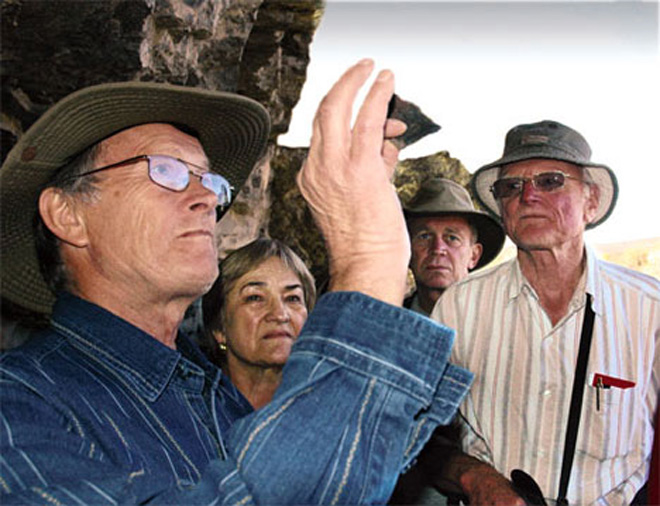I was standing in a dry riverbed somewhere on an immense farm in the Moordenaars Karoo. The farm is named Geelbek from the Geelbek River that runs through it. The seriously weathered kareeboom in front of me is where the Hottentot people who lived here are said to have been cremated. Their ashes were strewn over the ebbing water to flow downstream – back south towards the cave where we started this symbolic journey of birth, life and death about 24 hours ago.
The gnarled kareeboom on this sacred site is said to embody the Hottentot god who guarded the borderline between life and death. His name was Kari and his weapon a trident – represented by the trident leaves of this sanctified tree (Rhus lancea).
Kari/Karee. Is it a coincidence that these two names sound so similar, depending on how you pronounce them? Ever wondered why it was named a Karee-boom? What is a Karee? Is it Afrikaans or English or some native tongue?
One theory is that it is an ancient Indian name of the Dravida (Indian) people’s god. The Dravida is said to be the oldest known civilisation in India, whose men were skilled maritime navigators. They sailed to Africa in search of gold and mixed with the indigenous Bushmen women, leading to the birth of a new progeny: the Hottentot (properly pronounced Otentottu, which describes them as “mixed”) or Quena (pronounced Kena and meaning Red, after their Red God). Or so the story goes.
Around me there was more evidence of this apparently Indian influence in the names of rivers, koppies and places – which is hard to dispute. According to research, the most common word for river in Quena languages takes three forms: -ka, -kam and -kama. All three of them could be derived from the Dravida word “kam”, for water. Examples of this linguistic influence are the Dwyka, Gamka, Leeugamkarivier, Keiskamma, Tsitsikama, Karikama and Tarakama.
Other borrowings from India – names like Ramkop and Kanonfontein (in the Moordenaars Karoo) – are thought to have been phonetically adapted by the Dutch. Ram replaced Rama and Kanon replaced the Dravida kanai and Quena //ana. Both these words supposedly had their roots in India.
To confuse things ever more, no battle was ever fought anywhere near Kanonkop, which makes the Dutch form of the name even more questionable.
Another word in our everyday language that had its roots in India is cash, derived from kash – the earliest man-made gold coins used as currency by the Dravidians.
The first time I heard the claims of an Indian influence in early South African history and the Hindu-inspired temples in the Moordenaars Karoo was almost a year ago. It was said these “temples” had been mistaken for dilapidated former Bantu cattle kraals, though Bantu people never lived in the region.
My curiosity was pricked. I just had to go there and get the story myself. I consequently wormed my way onto a guest list to join Dr Cyril Hromn?k – the controversial researcher making these claims – on a field trip he undertakes four times a year, timed to coincide with the seasonal equinoxes and solstices. This helps observers to understand the mathematical and astronomical precision of the advanced people who built these temples.
One more thing that had me dead set on going was the “Major Moon Standstill” – an astronomic phenomenon that occurs every 18.6 years. It last took place on one of the said weekends in 2006, when the “shift” in the moon’s rising and setting could be observed.
The official invitation I received from Dr Hromn?k by e-mail read:
“You are misled if you accept the archaeological scenario which postulates only some kind of Bantu Iron Age and Bushman Stone Age before the arrival of the Portuguese and the Dutch in South Africa.
The real history began 1200 years before the arrival of the Bantu-speakers (Sotho, Tswana, Xhosa, Zulu, etc.); and it wasn’t a primitive history either. Gold of Africa attracted to Africa’s shores Dravidian (Indian) gold-seekers and they mixed with the indigenous Kung (Bushmen), producing the Mixed Otentottu (Hottentots) or Quena, whose Coloured descendants form the major part of the Cape Population. Later on, the Black Bantu-speakers were brought into the system.
With the Indian gold-seekers came the sophisticated cosmologically based religion, which called for advanced astronomy and this is reflected in the thousands of stone temples they built. Surprise, surprise, the Rock Art forms an important part of it.
The ancient astronomy of these temples is still working. Yes, the Indo-Quena ancestors of the modern Quena engaged in this kind of scientific pastime. If you want to understand the Jewish, Indian, Egyptian, Mesopotamian and even Christian calendars (and religion), you should not miss this opportunity.
I flew to Cape Town on Friday 24 September (two days after the actual spring equinox), and embarked on a 300km solo mission in the comfort of a Nissan Pathfinder. My destination was Geelbek Farm (or Faber’s Kraal as it was called by the Dutch burgers). This is a vast stretch of unspoiled Karoo plains and mountains encompassing some 6000ha. Its name was already shrouded in historical prejudice. Geelbek (yellow mouth) is said to have been the name the Dutch gave the Quena due to their yellowish brown skin tone.
The farm’s topography fluctuates substantially. It is a 4×4 enthusiast’s dream of stony outcrops, koppies, a canyon, dry riverbeds that vary from thick, soft sand to rocky, rough terrain demanding 4-low most of the time – especially if you want to reach the temples on sun-clocked time!
A group of people were already congregating at the farmhouse when the Pathfinder came to a dusty halt. Some guests were booked into the farmhouse for the weekend and others into nearby cottages.
They were an interesting bunch, all right. Among them were two Americans, two Poles, two Zimbabweans, a Spanish mother and her son, a Xhosa man, two mining geologists from Gauteng, an Australian student, an artist from Cape Town, a Quena-related trio from Somerset West, a medical doctor and his wife from Betty’s Bay, Dr Hromn?k’s son, Marius and the owner of the farm, David Luscombe and his adult children Leshane, Mark and Michelle.
The majority were politely competing to share a word with the man we all came to meet before embarking on the field trip at midday.
Cyril Hromn?k is a historian and researcher with an MA in African History and Portuguese and a PhD in African, South Asian and Latin American history. An authority on the origins of the Quena or Hottentot people, he has an archive of published articles and a notorious book, Indo-Africa – towards a new understanding of the history of sub-Saharan Africa (a true eye-opening, bewildering read) under his belt.
What make him even more fascinating (to me at least), is his linguistic skills. He speaks eight languages, and maintains that this helps him identify the origins of words and geographical names. This in turn gives insight into the foreign influences – and the unrecorded history – that played a role in shaping various civilisations, including the Quena. In short, a country’s unwritten history can be traced by the historical names given to its rivers and mountains, in particular.
“In our case, Hromnik pointed to the presence of ancient Indian words in indigenous languages and geographical names – words that found their way into the local vocabularly over the years.”
Bursting with excitement and a desire to rediscover (and hopefully rewrite) history, we braced the wind and followed our “guide” up a rocky slope to our first destination – a shrine close to the Luscombe’s farmhouse.
At first glance it seemed insignificant, until Hromn?k drew attention to the shape of the heap of stones. He said it depicted an arrowhead, pointing 28.5 degrees south-west, to a V-shape gap in the Witteberge, where the sun sets at the summer solstice. At the winter solstice, the sun rises in a similar V-shape gap at the opposite end o
f a 51km-long line.
Cosmologically connected with the arrowhead, on a faraway hill, was a lone tree*. Getting there called for some serious 4×4’ing, and two elderly Polish and two South African ladies teamed up with me (and the Pathfinder) to tackle the trip in style.
As Hromn?k predicted, a shrine was found under the tree, which beckoned us towards a cave adjacent to the dry Geelbek River bed. The cave and overhangs were covered with red dots and a few rock paintings.
According to Hromn?k, these were not Bushmen paintings, since there was no historic proof that Bushmen lived in the Karoo in the period when rock art was painted. In fact, he said his studies showed that Bushmen never painted, and none of them ever claimed that their ancestors did so.









